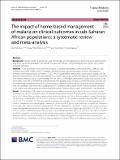| dc.description.abstract | Background
Malaria remains a significant cause of morbidity and mortality globally and continues to disproportionately afflict the African population. We aimed to evaluate the effect of home management of malaria intervention on health outcomes.
Methods
In our systematic review and meta-analysis, six databases (Pubmed, Cochrane CENTRAL, EMBASE, CAB Abstracts and Global Health, CINAHL Complete, and BIOSIS) were searched for studies of home management of malaria from inception until November 15, 2023. We included before–after studies, observational studies, and randomised controlled trials of home management intervention delivered in community settings. The primary outcomes were malaria mortality and all-cause mortality. The risk of bias in individual observational studies was assessed using the ROBINS-I tool, whilst randomised controlled trials were judged using a revised Cochrane risk of bias tool and cluster-randomised controlled trials were evaluated using an adapted Cochrane risk of bias tool for cluster-randomised trials. We computed risk ratios with accompanying 95% confidence intervals for health-related outcomes reported in the studies and subsequently pooled the results by using a random-effects model (DerSimonian–Laird method).
Results
We identified 1203 citations through database and hand searches, from which 56 articles from 47 studies encompassing 234,002 participants were included in the systematic review. All studies were conducted in people living in sub-Saharan Africa and were rated to have a low or moderate risk of bias. Pooled analyses showed that mortality rates due to malaria (RR = 0.40, 95% CI = 0.29–0.54, P = 0.00001, I2 = 0%) and all-cause mortality rates (RR = 0.62, 95% CI = 0.53–0.72, P = 0.00001, I2 = 0%) were significantly lower among participants receiving home management intervention compared to the control group. However, in children under 5 years of age, there was no significant difference in mortality rates before and after implementation of home management of malaria. In terms of secondary outcomes, home management of malaria was associated with a reduction in the risk of febrile episodes (RR = 1.27, 95% CI = 1.09–1.47, P = 0.002, I2 = 97%) and higher effective rates of antimalarial treatments (RR = 2.72, 95% CI = 1.90–3.88, P < 0.00001, I2 = 96%) compared to standard care. Home malaria management combined with intermittent preventive treatment showed a significantly lower incidence risk of malaria than home management intervention that exclusively provided treatment to individuals with febrile illness suggestive of malaria. The risks for adverse events were found to be similar for home management intervention using different antimalarial drugs. Cost-effectiveness findings depicted that home malaria management merited special preferential scale-up.
Conclusions
Home management of malaria intervention was associated with significant reductions in malaria mortality and all-cause mortality. The intervention could help decrease health and economic burden attributable to malaria. Further clinical studies are warranted to enable more meaningful interpretations with regard to wide-scale implementation of the intervention, settings of differing transmission intensity, and new antimalarial drugs. | en_US |
